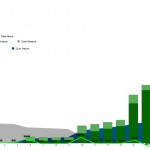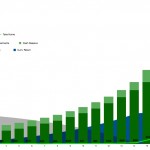[NOTE: I updated this post with more detailed examples]
Background: part 3, part 2 and part 1.
In the interview with Jon Gunn in Part 3, I mention that I’ve been thinking of what “version 2” of the Personal Investment Contract might look like. Here’s the model:
- Investment Amount - Same as before, intended to give the individual some time to pursue their passion (or figure out what that is) without having to worry about how to support themselves.
- Maximum Return - The cumulative total amount that the investor can receive as return on their investment. If and when this amount is reached, the contract is over.
- Annual Exclusion - The amount of annual income the entrepreneur can make without having to share any of it with the investor.
- Minimum Revenue Share - The minimum percentage of gross income the entrepreneur returns to the investor after deducting the Annual Exclusion.
Following are some examples of various different career paths and uses for a PIC. Click on the thumbnails to expand the graphs. These are modeled with various “reasonable” assumptions but if you want to experiment with how it might apply to you or under different assumptions, here’s the spreadsheet.
Example 1: Entrepreneur
- Investment Amount: $50K
- Maximum Return: $2M (i.e. 40x )
- Annual Exclusion: $100K
- Minimum Revenue Share: 25%
Example 2: Social Innovator
- Investment Amount: $100K
- Maximum Return: $1M (i.e. 10x)
- Annual Exclusion: $50K
- Minimum Revenue Share: 30%
Example 3: Small Biz Expansion
- Investment Amount: $300K
- Maximum Return: $1.8M (i.e. 6x)
- Annual Exclusion: $0
- Minimum Revenue Share: 40%
Example 4: Career Change
- Investment Amount: $1M
- Maximum Return: $4M (i.e. 4x)
- Annual Exclusion: $200K
- Minimum Revenue Share: 60%
Example 5: Investor
- Investment Amount: $3M
- Maximum Return: $300M (i.e. 100x)
- Annual Exclusion: $250K
- Minimum Revenue Share: 100%
Several things to note: the Minimum Revenue Share is calculated from the gross income (all sources) as reported on your tax return; you get to deduct the Annual Exclusion amount before figuring and paying taxes. If your effective income tax rate is 40% and you quit your job — using the Investment Amount to live off of — you’ve just stretched out your runway by 40% (i.e. you don’t pay taxes on the money someone invests in you). Finally, this contract gives you incentive to pay more than the Minimum Revenue Share to your investors, since the more you return, the quicker you reach the Maximum and end the contract.
Alternative Institutions, Cooperation, Happiness, Incentives, Innovation, Interventions, Investing, Psychology, Scarcity / Abundance, Social Capital, Social Entrepreneurship, Trust